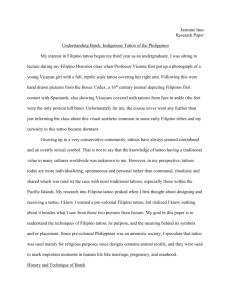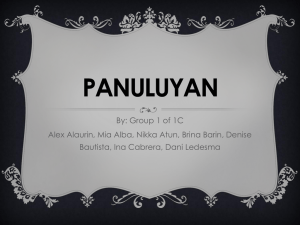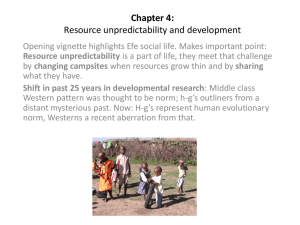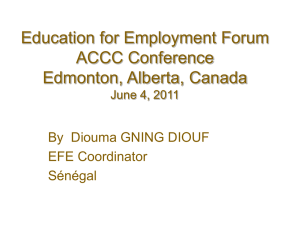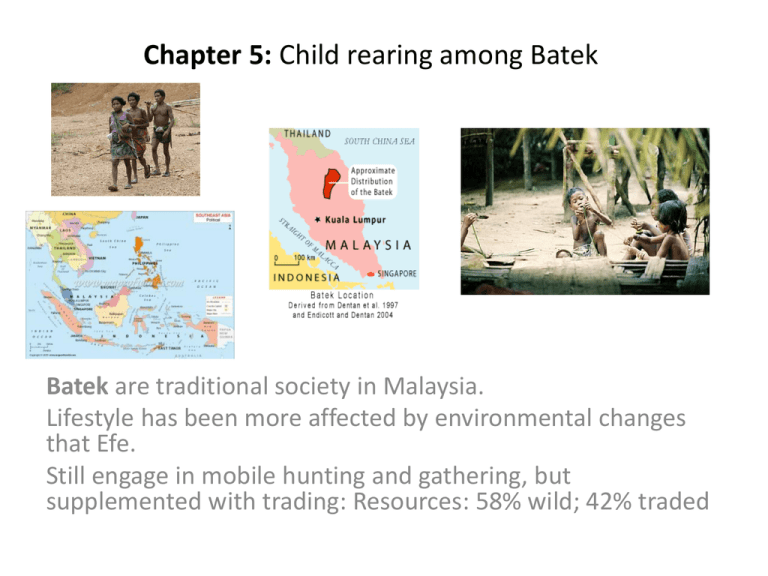
Chapter 5: Child rearing among Batek
Batek are traditional society in Malaysia.
Lifestyle has been more affected by environmental changes
that Efe.
Still engage in mobile hunting and gathering, but
supplemented with trading: Resources: 58% wild; 42% traded
Batak: Sexual division of labor
• Men hunt with blow pipes:
monkeys, gibbons, squirrels,
birds.
• Women: gather tubers,
mushrooms, fruits, etc. Some
overlap: men also did some
gathering, women did some
hunting of smaller game and
fishing.
• Both collect rattan, a vine
traded for various products
(tea, tobacco, pots, knives).
• Note: resource uncertainty
seems less an issue with Batek
compared to Efe
Batek homelife
• Camps: 5-8
families in separate
huts. Both
individual/familial
autonomy and
cooperative
sharing within
camps was highly
valued
Batek and Efe
•
•
•
•
Similarities:
Early infant indulgence and constant maternal contact.
Community interest and involvement in infant/child care including fathers.
Play in mixed aged/sex groups ages 2-8, considerable overlap in boy/girl
activities
• Birth: less communal than Efe; mother plus female attendants. Baby
quickly given to mother.
• Striking characteristics of Batek
• Highly uncompetitive games and activities
Growing up Batek
• Around age 8, boys/girls
segregate themselves and
specialize in gender-specific
activities accompanying same
sex parent. Seems to happen
naturally, little direction from
parents.
• No indication that either
gender role “favored” over
another, both valued
• Most learning: via
observation and imitation,
little direct instruction
Growing up Batek
• Most Batek child-rearing strategies
appear to be common-sense
solutions to practical challenges.
The only practice that appears to
be quite deliberate is allowing very
young children to “learn by doing”
in order to develop skill and
autonomy. This meant playing
with knives and fire.
• Parental authority: largely
exercised through supernatural
agents who would punish,
predatory animals and the
dangerous outsider. Parents did
expect to have inherent authority!
Growing up Batek
• Marriage: Many adolescent
“trial” marriages; marriage
(late teens, early 20’s)o
marked by cohabitation and
small feast provided by
couple, gifts given to
couple; but other than that
little ceremony or ritual.
• Divorce: not uncommon,
more likely early on and
childless. More divorce
seems to add more
caregivers to children
rather than subtract.
Batek non-aggressiveness
• Beginning ages 1-2, toddler’s aggressive acts met by
active separation by parent (e.g. kid hits at another,
mom picks up kid and removes kid from situation).
• Aggressive possessiveness met by ignoring.
• Main strategies of teaching non-aggression: nonrewarding; ignoring; separation; modeling nonaggression.
Batek morality
• Batek morality:
(implicit; enforced by
social pressure and
divine punishment)
• Respect others
• Be self-reliant
• Help others (share
food)
• Be non-violent
• Be non-competitive
Enforcing moral order
•
•
•
•
•
Enforcing moral order:
For a serious offence one might be
abandoned by others
Batek highly sensitive to public
opinion
Ke’oy: “hot heart” leading to
depression. Harming another was
thought to produce ke’oy in the
harmed person. Offender must cut
themselves put blood on leaves and
rub leaves onto the chest of victim. To
be accused of causing another ke’oy
was deeply damaging.
Numerous taboos: enforced by
supernatural agents through disease or
rejection of one’s soul after-death,
thus becoming a wandering ghost.
Taboos include socially disruptive and
or disrespectful acts.
Batek moral ideal
• cooperative
autonomy, selfreliance but with
strong obligations to
others. Others were
essential to survival.
• Contrast with rugged
individualism of
American West.
Promoting cooperative autonomy: Role of ritual
• Work week: 20-30 hours; plenty of time for leisure/discussion/play
• Thunderstorm ritual: Batek particularly feared thunderstorms,
blood sacrifice ritual was often used for protection. Blood sacrifice
– cut oneself, mix blood with water and toss upwards or
downwards.
• Group ritual: Singing and trance induction. Usually done before
fruiting season. Sometimes done for ill person. Involved entire
camp, sometimes members of other camps would join.
Preparations might take days. Group dancing with shamans in the
center going into trance states.
Lesson of Batek childrearing
• Batek example suggest
free-range kids
approach to parenting
more akin to ancestral
childrearing than “tiger
mom” or “natural
growth” styles.

